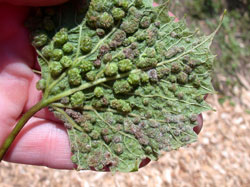

California (State Appellation)
Life in the Post-Phylloxera Era
What exactly has phylloxera wrought?
by
Alan Goldfarb
November 18, 2008
 remember when I first began writing about phylloxera around 1991, I warned that “your wines are about to get more expensive” because of it, and that due to the enormous capital outlay to replant, we were going to see a lot of fallout as wineries would go belly up.
remember when I first began writing about phylloxera around 1991, I warned that “your wines are about to get more expensive” because of it, and that due to the enormous capital outlay to replant, we were going to see a lot of fallout as wineries would go belly up.
I was correct on the first count (see wine prices in 2008), but not so right on the second, although replanting expenditures led to a lot of debt, and a flurry of corporate takeovers.
On the positive side, I also wrote that because of the replantings, vintners would
 now be able to implement new methods of growing grapes; and would get the opportunity to pull out varieties that were not selling (i.e. Riesling, Chenin Blanc, etc.), and put into the ground varieties that the consumer was just waiting to gobble up (Cabernet, Cabernet, Cabernet).
now be able to implement new methods of growing grapes; and would get the opportunity to pull out varieties that were not selling (i.e. Riesling, Chenin Blanc, etc.), and put into the ground varieties that the consumer was just waiting to gobble up (Cabernet, Cabernet, Cabernet).
But in my cynical journalist’s mind, I thought at the time that putting a silver lining on the ravages of phylloxera – mostly emanating from the folks inside the industry – was mostly spin. And it was, but it was spin, that 20 years later, was steeped in empirical knowledge that came true.
Out with Phylloxera, In with Terroir
Glibness and skepticism aside, what the Post-Phylloxera Era (PPE) really wrought was the planting of the right grapes in the right places (Pinot, Merlot, Chardonnay in cool climates; Cab, Cab Franc in the warmer climes).Respect for terroir was born in America.
Most important, however, what PPE brought us – vastly but generally speaking – was excellent quality of wines. And that new paradigm that infused winemaking during the last 20 years has brought consistently well-made wine throughout the mostly new world. (See Australia, Argentina, South Africa, Canada.)

Phylloxera leaf galls on grape leaf.
The ones that survived were not on the rootstock now infamously known as AXR-1, the villain in the piece, upon which the louse phylloxera gorged and gorged some more. As a result, other thought-to-be resistant rootstocks were planted.
AXR is all but a memory (for the nonce), shoved into the annals of history not unlike the Eagletons, Quayles and Palins of the world. But like Palin, the nasty bugger (it’s phylloxera of which I speak) could someday come back.
Rich Kunde, who ran the Sonoma Grapevines nursery for 25 years until he sold it in 2000, thinks phylloxera might someday raise its microscopic head again. As he so eloquently tells me, “Everything that we have (rootstocks) is basically tolerant,
 but not immune. Phylloxera will find its way around, somewhere.” But Garvey for one doesn’t think so. “There may be some other strains, which is always a concern (and) there is not a 100 percent resistant (rootstock).”
but not immune. Phylloxera will find its way around, somewhere.” But Garvey for one doesn’t think so. “There may be some other strains, which is always a concern (and) there is not a 100 percent resistant (rootstock).”
Among the things that phylloxera wrought over the last two decades – new clones, newly placed varieties, trellis systems, vine spacing, more precise row facings, soil amendments, and more sophisticated irrigation regimens – it is the rootstock that is perhaps the most confounding.
I’m told now though that Andy Walker at UC Davis (the same institution that brought you AXR) is testing new rootstocks that Rich Kunde calls “Everything Resistant”.
These new rootstocks may well prove to be other “arrows” in viticulturist’s “quivers” as Garvey characterizes it. What he alludes to is the possibility that if the most prevalent rootstock that was adapted in recent years in Rutherford and Oakville - the heart of the Napa Valley floor’s Cab Country - proves not to be sustainable, we’re in for another great replanting cycle.
About 70 percent of vineyards in Rutherford and Oakville – particularly on the west side of Highway 29 - are planted to a rootstock un-sexily named 039-14. Unlike AXR, which was good for up to 30 years (before the bug got it), 039-14’s lifespan, Garvey thinks, is good for about 15 years. And we’re fast coming up on that number.
That’s why Davis’ test plantings of new “everything resistant” rootstocks are so crucial. With 039-14, Garvey says he’s seeing other kinds of bugs, such as nematodes, which is causing fanleaf roll, a virus that destroys vines.
It’s Super-Rootstock to the Rescue
If Andy Walker’s super-rootstocks prove potent against vineyard interlopers, all we have left to worry about is the vertical shoot positioning (or VSP) trellis system, which came into being in the PPE, and which some are beginning to question as to its efficacy.I once heard Tony Soter, the former winemaker for Spottswoode and Etude say that VSP – another PPE derivative - is the absolute wrong system because it’s effectively a “hothouse” that drives up sugars and therefore alcohol levels.

Pat Garvey
One may argue – this scribe included – that one result of the PPE is to bring us overwrought, unbalanced wines. But Garvey reveals to me that when Flora Springs began its replanting project in ‘89, he experimented with picking later than what was the norm. He found, not to anyone’s great surprise, that when picked at 25.5° Brix (sugar), the wines exhibited more intense flavor.
That was before certain critics began favoring those wines, which today are not being picked at the relatively modest but much higher degree to which Garvey experimented. Garvey is not a fan of high alcohol wines, nor am I, but then who are we to condemn those wines that people seem to love; and which seem to be selling like crazy, even in this PPE economic market?
Phylloxera was the turning point that has defined the modern winemaking era. The “gloves came off” as Garvey puts it and “we were just going nuts” on new clones, new rootstocks, etc., etc.
"We created and freewheeled and tried different things. We became very open minded … The change was huge. It was pretty wild around this area. Expertise was
 moving back and forth across the ocean. Those patterns of knowledge and expertise cross-pollinated different parts of the world
moving back and forth across the ocean. Those patterns of knowledge and expertise cross-pollinated different parts of the world










 READER FEEDBACK: To post your comments on this story,
READER FEEDBACK: To post your comments on this story,




